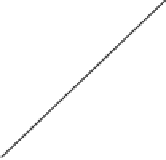Geoscience Reference
In-Depth Information
300
w=6.5%, e=0.43
w=5.1%, e=0.47
200
w=13.2%, e=0.42
w=13.7%, e=0.49
w=11.1%, e=0.51
w=0%, e=0.47
100
w=18%, e=0.53
50
10
20
30
50
100
200
Total vertical stress
σ
v
(kPa)
Figure 6.15.
Normalized Young's modulus versus total vertical stress for samples
of Perafita sand at different water contents and densities
6.5. Interpretation of results using the effective stress concept
The interpretation of the triaxial tests is based on the assumption that the
effective stress concept is valid for determining both the failure criterion and the
elastic moduli
E
v0
, and that a unique relationship exists between
p'
and
q
in the first
case, log(σ'
v
) and log(
E
v0
) in the second, whether it is for saturated or unsaturated
specimens.
When the soil is quasi-saturated,
p'
is given by Terzaghi's expression; in the case
of unsaturated soils, the values of
p'
are derived from the micromechanical model
described in section 6.2, provided that the “characteristic dimension”
R
has been
determined. In the case of a real granular medium,
R
loses the physical meaning of a
grain size, but becomes a fitting parameter of the model.
Considering first the tests on quasi-saturated specimens (i.e. with
S
w
> 75%), it is
possible to derive the maximum strength criterion from the large strain triaxial tests,
with the equation:
q
= η
max
(
p
+ σ
'
cap
), where σ
'
cap
=
p
a
- p
w
[6.23]
Thereupon, the value of the “characteristic dimension”
R
of the
micromechanical model is chosen so that the final points of the tests on the
unsaturated samples (with
S
w
< 50%) are located near the previously determined


















































Search WWH ::

Custom Search